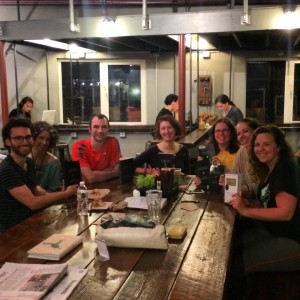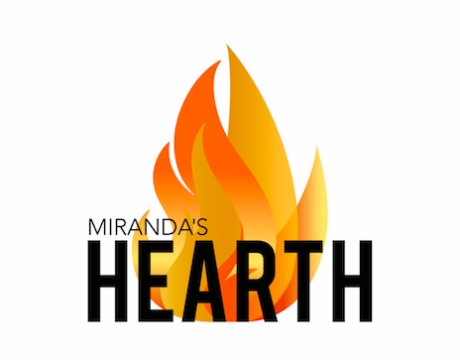What We See When We Read
 Reading this book made me analyze what I see when I write. Sometimes I feel like I’m transcribing a movie. The point of view of the panel I’m describing is the point of view of the camera. The lighting is the same, too. But when I move to the characters, I can’t always describe their noses and cheekbones except perhaps to say “she had her mother’s cheekbones and coloring,” which isn’t necessarily helpful when I don’t describe the mother’s face. All writers are influenced by those who came before them- we’ve heard this many times. So how much of these characters- supposedly my characters- are actually someone else’s?
Reading this book made me analyze what I see when I write. Sometimes I feel like I’m transcribing a movie. The point of view of the panel I’m describing is the point of view of the camera. The lighting is the same, too. But when I move to the characters, I can’t always describe their noses and cheekbones except perhaps to say “she had her mother’s cheekbones and coloring,” which isn’t necessarily helpful when I don’t describe the mother’s face. All writers are influenced by those who came before them- we’ve heard this many times. So how much of these characters- supposedly my characters- are actually someone else’s?
Mapping is a reoccurring theme in our discussions. I’m not sure how much of this can be attributed to our second book club selection, The Selected Works of T.S. Spivet, or simply our minds. Regardless, Mendelsund devotes a section of the book to mapping. You may remember a teacher mapping a plot for you (it probably looked a bit like a triangle) but Mendelsund looks at more confusing, free-form maps. As both a teacher and a writer, I love this section. I’ve mapped emotional arcs using similar drawings and explained concepts to students with similar scratches. While I may not agree with the way Mendelsund maps certain books, it makes me want to layer a number of people’s maps of the same book. (If you read our July selection,Americanah, please bring a map!)
My mom brought up something I’d also thought of when reading: Jasper Fforde’s Thursday Next novels. In these novels, the protagonist travels into fiction and explores how it’s created. Much of what Mendelsund discusses is brought up in this series (published before What We See When We Read) but, as a postmodern work of fiction, in a hilarious way. Thursday Next remarks how two characters from different books often remind readers of each other, because they’re actually played by the same person in the book world. Meanwhile, carrot sticks are orange rods (based on their descriptions), there are few smells, and people who are sick either have a major illness or a minor head cold (nothing in between). Personally, I think Fforde’s books are a more enjoyable way to experience these revelations, but Mendelsund’s book has its own merits, and is certainly more discoverable for those more interested in nonfiction or who prefer to avoid the delights of fantasy. Either way, it’s an interesting concept to consider.

Pingback: tiket pesawat murah()
Pingback: seks izle()
Pingback: gta 5 money generator()
Pingback: porno()
Pingback: yesim aktas()
Pingback: reserver hotel pas cher()
Pingback: warehouse rentals Miami()
Pingback: castle clash hack, games cheats, viagra pills, porn, fifa 16 hack, free xxx videos, pirate kings hack()
Pingback: www.recycletotes.com()
Pingback: Free hosting()
Pingback: economics tuition()
Pingback: economics tuition()
Pingback: economics tuition()
Pingback: economics tuition singapore()
Pingback: www.baredmonkey.com()
Pingback: chirie auto()
Pingback: https://twitter.com/GuaranteedPPC()
Pingback: DraftKings promo code()
Pingback: pre check boarding()
Pingback: how to buy steroid online()
Pingback: The Ultimate Guide to Using PBN Links for Niche Sites()
Pingback: suing a doctor in philadelphia()
Pingback: informatica()
Pingback: cosmetique bio en ligne()
Pingback: likri.com()
Pingback: maquillage pas cher et de qualité()
Pingback: click this link()
Pingback: recycletotes.com()
Pingback: 100k Factory Ultra Edition()
Pingback: Best Blog in India()
Pingback: dna wealth blueprint 3.0()
Pingback: angara fahise()
Pingback: Question Papers()
Pingback: angara fahise()
Pingback: angara fahise()
Pingback: bursa orospu()
Pingback: Term Life Insurance()
Pingback: http://www.parkour-network.ru/node/10416()
Pingback: http://mx2.sixfigureforex.com/forex-reviews/get-more-out-ppc-targeted-landing-pages-lead-nurturing()
Pingback: blogspot.com()
Pingback: https://tribot.org/#contact()
Pingback: hampton bay online()
Pingback: subways surfers()
Pingback: How to scan a car()
Pingback: www.juegosfriv.one/()
Pingback: Bank Tracker Bot()
Pingback: https://tribot.org/()
Pingback: Dragon Ball Super Episode 42 English Sub()
Pingback: getcashforsurveys review()
Pingback: cdt.edu.vn()
Pingback: 3 seater sofa()
Pingback: newtube sirius445 abdu23na3425 abdu23na78()
Pingback: topfuck123gals.mobi find out more t3wOTJ()
Pingback: noscnobobsbart1983.wikidot.com i'll provide a link()
Pingback: xxxvipsearch.mobi()
Pingback: click to read more()
Pingback: pronvipse.mobi()
Pingback: schatshadowrank.mobi visit web page 86Lz()
Pingback: schatfreese.mobi()
Pingback: schattopengine.mobi more on this page()
Pingback: pronshadowengine.mobi follow this link()
Pingback: pronbestrank.mobi()
Pingback: adultshadowengine.mobi continue mh2()
Pingback: schatshadowrank.mobi more on this page()
Pingback: just click for source()
Pingback: speedsexsite.mobi click for details()
Pingback: check this out()
Pingback: click()
Pingback: visit the page()
Pingback: click at this page()
Pingback: fastsexsearch.mobi()
Pingback: topsexportal.mobi click to find out more()
Pingback: fastfuckse.mobi read more()
Pingback: topdatingse.mobi link to a continuation()
Pingback: oklandviphomeguard.info source()
Pingback: oklandbestsecuritysystems.info link rHO()
Pingback: oklandtophomeguard.info page address AHW()
Pingback: oklandviphomesecurity.us link to details t8D()
Pingback: oklandtophomeguard.us more on the page ZNd()
Pingback: address()
Pingback: oklandviphomeguard.us this web page WrAuv()
Pingback: oklandbesthomesecurity.info read AexiW()
Pingback: oklandbestsecuritysystems.us click to read more()
Pingback: more information()
Pingback: youtube.com Coub видео()
Pingback: Web Design()